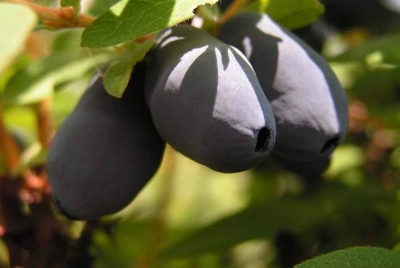
- Growth type: undersized
- Description of the bush: compact
- Bush height, m: 0,8-1
- Escapes: thin, curved, slightly pubescent
- Leaves: elongated-oval with pointed apex, slightly concave
- Transportability: good
- Crown: reverse conical
- Fruit size: large
- Fruit weight, g: 0,8-1,2
- Fruit shape: obovate with pointed apex
In the last 20 years, edible honeysuckle bushes have been increasingly found in Russian gardens. The plant is remarkable in that its unusual blue fruits ripen the very first in the season. For example, the Nizhegorodskaya early honeysuckle variety, justifying its name, will provide its owner with the opportunity to enjoy the first berries even before the strawberries ripen.
Breeding history
Nizhegorodskaya early is a seedling obtained after free pollination of the honeysuckle variety Turchaninov. The work on the culture was carried out by the Nizhny Novgorod State Agricultural Academy. The variety has been under strain testing since 1992. Recommended for cultivation in the Volga-Vyatka region.
Description of the variety
Compact bushes of Nizhny Novgorod early grow no more than a meter. The crown is noted as reverse conical. Elongated leaves are usually in dark green tones, medium size, lanceolate in shape. The root system of the variety has a superficial, fibrous.
Fruit characteristics
Honeysuckle berries Nizhny Novgorod early obovate, pointed tip. The fruits are large, their size is 12-16 mm. The weight of the berries varies from 0.8 to 1.2 g. At the beginning of fruit setting, they are green, as they ripen, the pulp and the skin turn dark blue, a wax bloom is observed on top of the berries.
Taste qualities
Nizhegorodskaya early belongs to the dessert varieties of honeysuckle. Her taste is sweet-sour, invigorating. There is a slight bitterness.
Ripening and fruiting
The culture first begins to bear fruit at 3 years of age. The berries of early maturing honeysuckle of the considered variety ripen 1.5 months after flowering. The fastest (from 10 to 15 June) this happens in central Russia, in the Moscow region, in the Volga region. But in the Urals, as well as in Transbaikalia, honeysuckle ripens a couple of weeks later.
Yield
The average yield of the early Nizhny Novgorod is 1.6-1.8 kg per bush. However, some sources say that with good care, honeysuckle bushes that have reached the age of 5-6 years can produce more than 5 kilograms of berries.

Self-fertility and the need for pollinators
Like many varieties of honeysuckle, Nizhny Novgorod early is self-fertile. Therefore, it is recommended to plant donor varieties next to it, such as Cinderella, Tomichka, as well as other options for early ripening.
Growing and care
Experts recommend planting the honeysuckle in question on warm spring days in March or April. Since the buds of the culture begin to swell too early, the shrub can be planted literally as soon as the soil in the garden allows it. However, in this culture, the dormant period begins just as early. Already at the end of July, yellowing and even falling leaves can be observed.Therefore, in the warm regions of the middle zone, planting work can be carried out in early August and until the end of September.
Nizhny Novgorod early grows well on light sandy soils. True, it is quite unassuming, it can grow on other soils: both loam and sandy loam, but it is important that they are neutral or slightly acidic, with a pH level of 6-6.5, without stagnant water. It is highly advisable to choose a sunny area: the lack of light makes the berries less sweet, and also reduces the yield. The place must be protected from the north wind, so honeysuckle is often planted along fences or fences.
Plants are easy to care for. Watering should be moderate, accompanied by loosening and weeding. Shrubs are fed three times a season. Do not forget about trimming.



Winter hardiness and the need for shelter
Nizhny Novgorod early - frost-resistant honeysuckle, can withstand temperatures down to -34 ° C. However, young seedlings should be covered, but first, moisture-charging watering and mulching must be carried out. If the bushes are fruitful, they are covered with a net with small cells to protect them from bullfinches: they love to feast on the buds.
































































